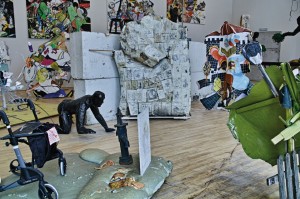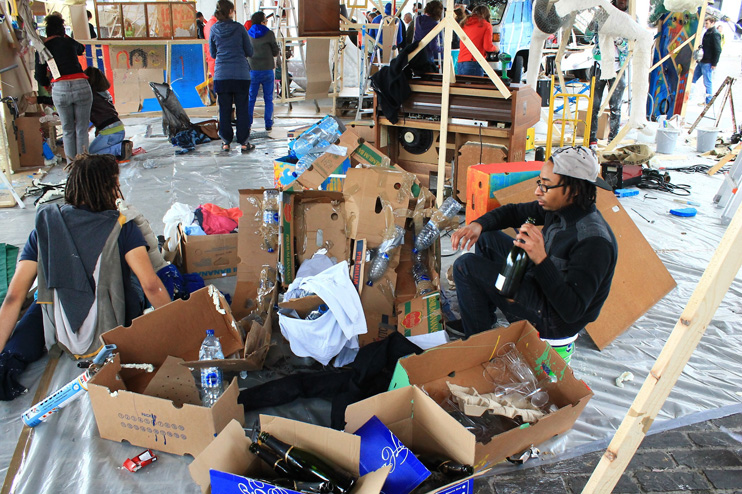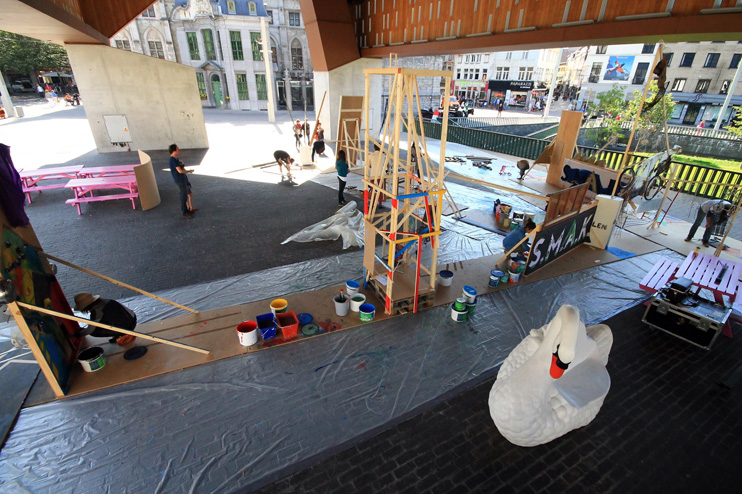
On occasion of David Bade’s exhibition ‘Zwaan Kleef Aan’ in S.M.A.K in Ghent, Belgium, IBB Curacao, Tirzo Martha and David Bade worked on a site project with people from Ghent. The work will be added to the big exhibition.
The exhibition will be on till September 21.
David Bade
David Bade (1970, Curaçao) makes drawings and absurd sculptures that he recycles from ‘worthless’ and building materials. He later assembles them to make tremendously expressive, room-filling installations which he scatters with short pieces of writing: personal anecdotes, caustic comments on current affairs, a humorous play on words, an ironic proverb and suchlike. In terms of form, he cites freely from banal contemporary culture, art history and the visual idiom of Curaçao, his native country, where influences from Western and African culture meet the tradition of the colourful Caribbean carnival and folk religion.
 Photos Omar Kuwas.
Photos Omar Kuwas.
Besides a passionate artist with an international career, David Bade is an inspiring teacher in charge of an art school he co-founded, a socially-engaged director of artistic community projects and a critical TV presenter of an arts programme for the general public (ArtMen). He stands in the middle of this life and has a lot to say about it, a huge amount in fact. He does this in his own intrepid way, using images, words and action. But there is one thing that is at the heart of all the projects he undertakes: interaction.
Instituto Buena Bista
The artists David Bade and Tirzo Martha, together with art historian Nancy Hoffmann, founded the Instituto Buena Bista (IBB) on Curaçao in 2006. The founders of IBB want to provide a platform for contemporary art that simultaneously stimulates awareness and enrichment of the indigenous cultural heritage while introducing to the island new cultural developments from around the world.
The Institute’s core activities consist of organising a visual arts orientation course for talented Curaçaoan youngsters between the ages of 15 and 25, and assigning them to a professional overseas follow-up course in the fine or applied arts. The IBB ensures that the students receive close supervision overseas, but also motivates them to return to Curaçao afterwards. After all, the Institute believes that creative talent and an academic background are necessary to break with the colonial past of the island and build a new society.
Since 2009, the Instituto Buena Bista has been situated in the grounds of the Capriles psychiatric clinic. The lessons take place in a converted pavilion and an open garden and thirty or so students and two artists from abroad work there in the residency programme AIR. The patients at the clinic are free to wander in and out, work together with the students or take part in communal activities. By opting for a psychiatric institution as a base, the IBB is taking an explicit social stand as well as acquiring a special profile in so doing: that of a cultural institution that can connect contemporary art with identity, education and psychiatry.
“Swan, hold fast”
“Swan, hold fast” by David Bade is a Gesamtkunstwerk with a strong social and interactive character. ‘Wailing Wall’, one of his sculptures that belong to the permanent collection of S.M.A.K. is used as the anchor point of the project. In the museum Bade rebuilds the wall into a vast, sweltering environment with a mix of older work, new creations and interventions of the Instituto Buena Bista. Later in the summer “Swan, hold fast” gets a counterpart in the historic center of Ghent. Under the market hall, David Bade & Instituto Buena Bista build a new wailing wall in close cooperation with various groups of city citizens. It will be a growing sculpture in a wide variety of materials to which new forms, colours, stories and layers of meaning will be added, depending on the daily groups of participants: youngsters from deprived backgrounds, psychiatric patients, art students etc. At the end of the workshop, parts of the new wailing wall will be taken to the museum in procession and ‘stuck’ to the original wall.
‘Swan, hold fast’ was made possible by the generous support of Electrabel, the Sikkens Foundation, the Mondriaanfonds, Arcelor Mittal et Ivago.


